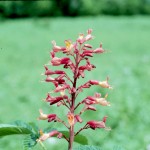Red Buckeye, Pale Buckeye , Scarlet Buckeye, Firecracker Plant
Aesculus pavia L.
Hippocastanaceae
Description
Red Buckeye is a shrub or small tree sometimes reaching 35 feet or 10.7 meters tall, but it typically matures at heights of 15 feet to 4.6 m tall. Its trunk reaches up to 20 inches or 30 cm in diameter and has smooth, gray or brownish bark. Large, deciduous, palmately compound leaves are attached by petioles up to 6 inches long. The five serrate leaflets are up to 7 inches long and up to 2.5 inches wide. The showy red flowers are displayed in erect clusters with tubular, five-lobed flowers and equal petals. The fruit is a leathery capsule containing one to three large glossy brown seeds up to 1 inch in diameter. The western variety of this species, which can be found in the western part of the Edwards Plateau in Central Texas, is similar but has pale yellow flowers.Habitat
The Red Buckeye is found in the eastern half of Texas all the way to the easternmost part of the Edwards Plateau and ranges east to North Carolina and Florida and as far north as Illinois. It is usually found in forests, along streams, and on rocky hillsides in East Texas, and the shrub form is seen in improved bermudagrass pastures. The yellow-flowered variety (i.e., Aesculus pavia L. var. flavescens) usually grows along streams in canyons of the western section of the Edwards Plateau, and hybrids with a variety of colors can be found growing there.Toxic Agent
Red Buckeye is a highly poisonous plant. A glycoside called aesculin and/or a narcotic alkaloid is responsible for the toxicity of this plant. Buckeye has poisoned cattle, horses, sheep, and swine as well as children. Intoxication usually occurs in the spring when young tender leaves are present, especially in times of drought when other forage is short. Deaths in cattle have also resulted from the consumption of mature seeds off the ground.Signs of Livestock Ingestion
Many animals exhibit severe signs of intoxication within a few hours of consuming the plant. Clinical signs include: Uneasy, staggering gait; Trembling; Weakness; Vomiting; Diarrhea; Depression. Some animals suffer severe central nervous system depression, become comatose and die. In most cases, unless they are comatose, recover if further consumption is prevented. Because the onset of clinical signs is so acute, seed fragments are usually present in the rumen of cattle found dead after eating the seeds.Management Strategies
Most fatal cases of buckeye poisoning occur when animals are forced to consume a large amount of plant material because another source of forage is not available to them. Supplying adequate hay through the winter and into the spring during drought can prevent poisoning. Animals that consume lethal amounts of the seeds usually have been introduced into previously vacant pastures in which seeds have accumulated. Keeping cattle in the pasture when the seeds are falling can prevent them from consuming a large amount of seed at one time; however, as little as 0.5% of a calf's body weight of seeds consumed has been found to produce severe poisoning.Images
Plant Characteristics
Flower Color: Red
Seed Type: Fruit/Berry
Duration: Perennial
Stem Texture: Hairless/Smooth
Growth Habit: Shrub (Woody)
Leaf Shape
 : Palmately Compound
: Palmately Compound
Season: Warm
Distribution
 : 01 - Pineywoods, 02 - Gulf Prairies and Marshes, 03 - Post Oak Savannah, 04 - Blackland Prairies, 05 - Cross Timbers and Prairies, 07 - Edwards Plateau, 08 - Rolling Plains
: 01 - Pineywoods, 02 - Gulf Prairies and Marshes, 03 - Post Oak Savannah, 04 - Blackland Prairies, 05 - Cross Timbers and Prairies, 07 - Edwards Plateau, 08 - Rolling Plains
Distributions
Distribution refers to the ecological region in Texas that a plant has been found. You can also view a clickable map.
Book: Toxic Plants of Texas (B-6105)
Collection: Toxics
Livestock Affected: Cattle, Horses, Pigs, Sheep
Livestock Signs: Coma, Depression/ Weakness, Diarrhea, Incoordination, Trembling, Vomiting/Regurgitation





